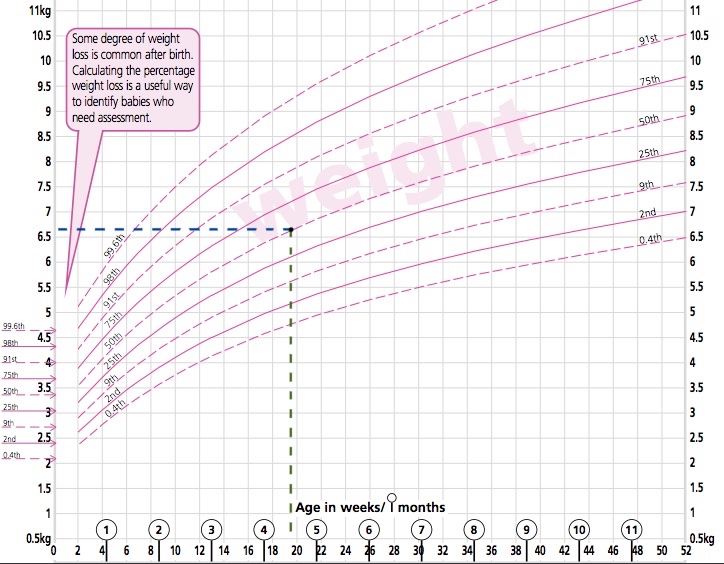Growth charts are used to plot a child’s weight, height and head circumference against the the normal distribution for their age and gender. The child’s measurements are plotted on a graph using a dot. The age is plotted on the x-axis and the weight, height and head circumference are plotted on the y-axis.
Growth charts have curves that indicate the normal distribution of growth over time. Centiles (cent– meaning hundred) indicate where a child’s growth compares to the normal distribution for their age and sex. It is important to use the chart that matches the sex of the child, as growth is different between boys and girls.
To illustrate how centiles work consider these examples: If a child is on the 50th centile, she is basically exactly average height for her age. If another child is on the 1st centile, he is shorter than 99% of children his age. If another child is on the 91st centile, she is taller than 91% of children her age.
The important thing when assessing a child where there are concerns about not gaining weight or height is to establish whether they are maintaining their centile. If a child is on the 9th centile, but they have always been on the 9th centile, that is much less concerning than a child that was on the 91st centile and is now on the 9th.
Plotting Growth Charts
Plotting growth charts is a common exam question and very common task for any doctor working on paediatrics. It is important to practice this skill. To help, here are some examples (all chart images were taken from RCPCH growth charts):
Plot a 4.5 month old girl that is 6.7kg:

She is almost perfectly on the 50th centile. This means her weight is higher than 50% of girls her age, and lower than the other 50%.
Lets say you saw her again at 1 year of age and she was 8kg:

Now her weight has dropped to below the 25th centile. More than 75% of girls her age are heavier than her. If she had weighed 6kg at 4.5 months (below 25th centile) her current weight would not be concerning, but the fact that she has dropped in centiles should raise questions about why she is failing to gain weight.
Phases of Growth
Children go through three phases of growth:
- First 2 years: rapid growth driven by nutritional factors
- From 2 years to puberty: steady slow growth
- During puberty: rapid growth spurt driven by sex hormones
Obesity
Obesity in children results from consuming more calories than are expended through activity and growth. Recently, access to readily available, affordable, hyper-palatable, high calorie foods has lead to the overconsumption of calories. There has been a shift from physical activities and outdoor play to sedentary activities such as video games and screens. This has contributed to an increase in childhood obesity.
Overweight is defined as a body mass index (BMI) above the 85th percentile and obese as above the 95th percentile. Obese children are often tall for their age and come from overweight families. If children are short and obese, consider endocrine investigations for an underlying cause, such as hypothyroidism. A pathological cause is rare.
The biggest immediate effect of obesity in children is bullying. Obese children at at higher risk of later developing impaired glucose tolerance, type 2 diabetes, cardiovascular disease, arthritis and certain types of cancer. Unless the family engages and addresses the issue it is likely to continue into adulthood and have all the associated negative health implications of adult obesity.
Last updated January 2020
